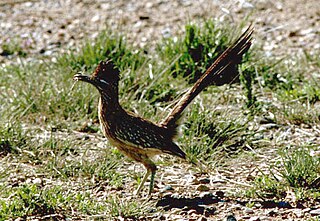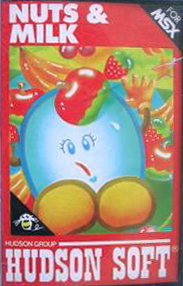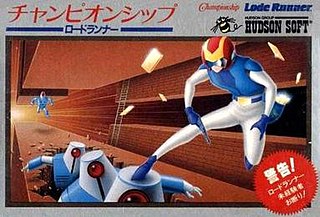Roadrunner is a bird of the genus Geococcyx.

Lode Runner is a 2D puzzle-platform game, developed by Doug Smith and published by Broderbund in 1983. Its gameplay mechanics are similar to Space Panic from 1980. The player controls a character who must collect all the gold pieces in a level and get to the end while being chased by a number of enemies. It is one of the first games to include a level editor.
Cell is a 64-bit multi-core microprocessor microarchitecture that combines a general-purpose PowerPC core of modest performance with streamlined coprocessing elements which greatly accelerate multimedia and vector processing applications, as well as many other forms of dedicated computation.

The roadrunners, also known as chaparral birds or chaparral cocks, are two species of fast-running ground cuckoos with long tails and crests. They are found in the southwestern and south-central United States, Mexico and Central America, usually in the desert. Although capable of flight, roadrunners generally run away from predators. On the ground, some have been measured at 32 km/h (20 mph).

Lode Runner: The Legend Returns is a 1994 remake of 1982's Lode Runner video game. It was released for Microsoft Windows, Mac OS, Sega Saturn, and Sony PlayStation.

The Phoenix Roadrunners were a minor league ice hockey team based in Phoenix, Arizona. They played in the ECHL beginning in the 2005–06 season and ceasing operations at the end of the 2008–09 season.

Bomberman is a maze video game developed and published by Hudson Soft. The original home computer game Bomber Man was released in July 1983 for the NEC PC-8801, NEC PC-6001 mkII, Fujitsu FM-7, Sharp MZ-700, Sharp MZ-2000, Sharp X1 and MSX in Japan, and a graphically modified version for the MSX and ZX Spectrum in Europe as Eric and the Floaters. A sequel, 3-D Bomberman, was produced. In 1985, Bomberman was released for the Nintendo Entertainment System. It spawned the Bomberman series with many installments building on its basic gameplay.

Hyper Lode Runner is a video game for the Game Boy from Bandai released in 1989 in Japan and 1990 in North America. It is based on the 1983 game Lode Runner from Broderbund. While each level in the original fit on a single screen, Hyper Lode Runner has a scrolling playfield.

Space Panic is a 1980 arcade video game developed by Universal. Predating Nintendo's Donkey Kong, and lacking a jump mechanic, Space Panic was the first game involving climbing ladders between walkable platforms. The genre was initially labeled "climbing games", but later became known as platform games. A ColecoVision port by CBS Electronics was released in the winter holiday season of 1982.

Lode Runner 2 is a puzzle-platform game released in 1998 for Mac OS and Microsoft Windows. It is a sequel to Lode Runner and its remakes. Like the earlier Lode Runner's Rescue, Lode Runner 2 has isometric-perspective 2D graphics. It was developed by Presage Software and distributed by GT Interactive for Microsoft Windows and MacSoft for the Macintosh.

Lode Runner Online: The Mad Monks' Revenge is an enhanced version of the 1994 game Lode Runner: The Legend Returns. The game includes online functionality so that players can battle or work together via network play. Despite the name, the game can be played as single-player and offline.
P. P. Hammer and his Pneumatic Weapon is a 1991 puzzle-platform game for the Amiga and Commodore 64 developed by Traveling Bits. It was influenced by Lode Runner (1983). The player controls a character called P. P. Hammer, who is on a quest to discover and acquire all treasures from a series of more than 60 levels.

Lode Runner 3-D is a Nintendo 64 game in the Lode Runner franchise. The game was developed by Big Bang and was released in 1999 in North America and Europe by Infogrames and in Japan by Banpresto. It is the first 3D game in the Lode Runner series.

Roadrunner was a supercomputer built by IBM for the Los Alamos National Laboratory in New Mexico, USA. The US$100-million Roadrunner was designed for a peak performance of 1.7 petaflops. It achieved 1.026 petaflops on May 25, 2008, to become the world's first TOP500 LINPACK sustained 1.0 petaflops system.

Nuts & Milk is a puzzle-platform game developed and published by Japanese software developer Hudson Soft in 1983. The game was released for the FM-7, MSX, NEC PC-8801, NEC PC-6001, and later to the Family Computer in Japan. Along with Lode Runner, it was the first third-party video game to be released on a Nintendo console.

Championship Lode Runner is a sequel to the 1983 puzzle-platform game Lode Runner. It was released in 1984 for the Apple II, Commodore 64, and IBM PC, then ported to the Atari 8-bit computers, Famicom, SG-1000, and MSX. Mostly the same as Lode Runner, Championship Lode Runner has levels that are much more difficult. Unlike the original, it does not include a level editor.

The Cal State Bakersfield Roadrunners are the intercollegiate athletic teams representing California State University, Bakersfield, located in Bakersfield, California. The Roadrunners compete at the National Collegiate Athletic Association (NCAA) Division I level as a member of the Big West Conference.

Douglas Edwin Smith, usually credited as Doug Smith, was an American video game designer and programmer best known as the author of the 8-bit game Lode Runner (1983), considered a seminal work of the 1980s.

Lode Runner's Rescue is a 1985 action game developed by Joshua Scholar for the Commodore 64 and Atari 8-bit computers as a follow-up to Doug Smiths's Lode Runner. Lode Runner was published by Broderbund, but the sequel was published under the Synapse Software name, a company acquired by Broderbund in 1984. Lode Runner's Rescue uses isometric projection to give a 3D feel.

Lode Runner is a video game developed by Presage and published by Natsume Inc. for the PlayStation in 1998. It is a compilation game combining ports of Lode Runner: The Legend Returns (1994) and the Japan-exclusive Lode Runner Extra (1997).

















